Cooling system - liquid, closed type, forced circulation
Consists of expansion tank, coolant pump, engine cooling jacket, thermostat housing, thermostat, radiator with electric fan and connecting hoses
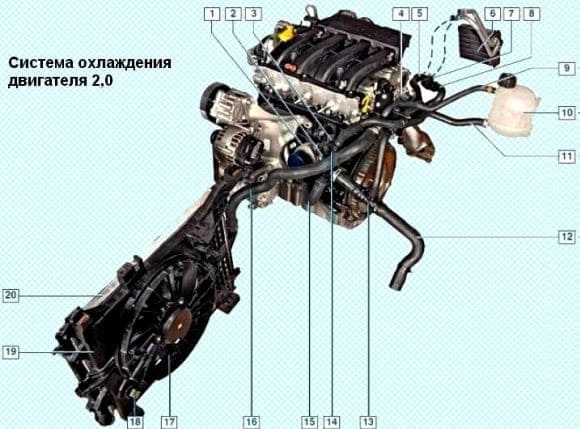
1 - heat exchanger; 2 - outlet hose of the heat exchanger; 3 - inlet hose of the heat exchanger; 4 - thermostat housing; 5 - inlet hose of the heater radiator; 6 - heater radiator; 7 - outlet hose of the heater radiator; 8 - air outlet fitting; 9 - steam outlet hose; 10 - expansion tank; 11 - inlet hose; 12 - radiator outlet hose; 13 - tee; 14 - splitter; 15 - fluid supply hose to the pump: 16 - radiator supply hose; 17 - fan impeller; 18 - additional resistor; 19 - fan casing; 20 - radiator
A heater radiator located in the passenger compartment and a heat exchanger (engine 2.0) are connected to the cooling system.
The system is filled with coolant through the neck of the expansion tank.
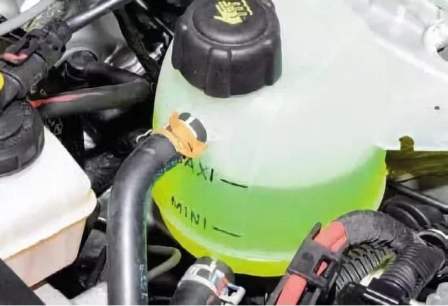
The expansion tank, mounted in the engine compartment on the left mudguard cup, is made of translucent plastic, which allows you to visually control the coolant level.
On the wall of the expansion tank there are MAX and MIN marks, between which the fluid level should be on a cold engine.
A steam outlet hose is connected to the upper fitting of the tank, connecting the tank to the thermostat cover.
The inlet hose of the expansion tank and the outlet hose of the radiator are connected to the hose of the inlet pipe of the coolant pump using a plastic splitter.

The tightness of the cooling system is ensured by the inlet and outlet valves in the cap of the expansion tank.
The exhaust valve maintains a higher than atmospheric pressure in the system on a hot engine.
Due to this, the boiling point of the liquid rises, and steam losses decrease.
The intake valve opens when the pressure in the system drops when the engine is cooling.
If the cover is lost, it cannot be replaced with a sealed cover without valves, even of a suitable size and thread - this will lead to an unacceptable increase in pressure in the cooling system (on a hot engine) and, as a result, leakage of coolant from under the hoses.
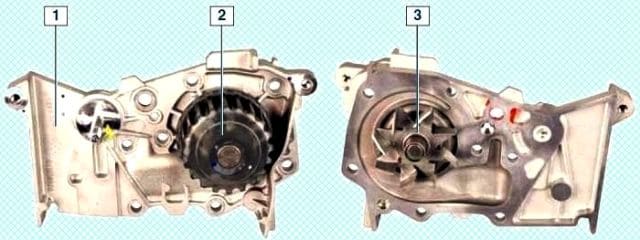
The circulation of fluid in the cooling system is provided by a coolant pump located on the right side of the cylinder block. Coolant pump - vane, centrifugal type.
The pump is driven by the timing belt from the crankshaft pulley, moreover, on the 1.6 engine, by the toothed side of the belt, and on the 2.0 engine, by the reverse (flat) side of the belt.
The pump consists of a housing, a sealed bearing assembly, an impeller and a drive pulley.
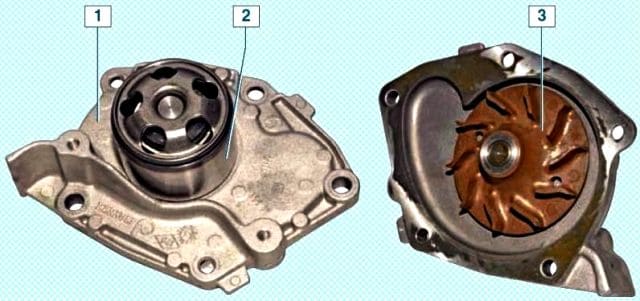
The liquid enters the pump through its inlet pipe located on the front wall of the cylinder block.
From the pump, fluid under pressure enters the cylinder block cooling jacket, then into the cylinder head cooling jacket, and from there to the thermostat housing attached to the left end of the cylinder head.
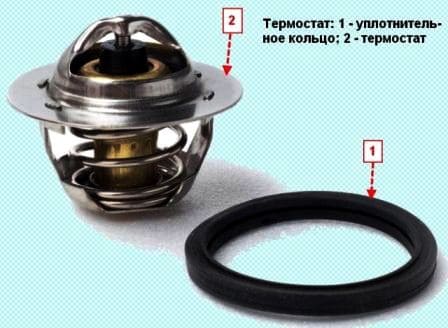
The thermostat, located in the housing and closed with a lid, helps to accelerate the warm-up of the engine, automatically maintains its thermal conditions within the specified limits and regulates the amount of fluid passing through the radiator of the cooling system.
Inside the thermostat there is a metal cylinder with a heat-sensitive filler (sock).
The balloon is hermetically sealed with a rubber insert.
When heated, the filler melts and increases its volume, squeezing the insert.
The rubber insert deforms, while the membrane bends and moves the stem that controls the thermostat valve.
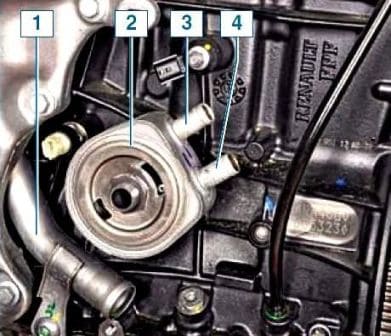
Elements of the 2.0 engine cooling system located on the front wall of the cylinder block: 1 - inlet pipe of the coolant pump; 2 - heat exchanger; 3 - fluid supply pipe; 4 - liquid outlet pipe
When the engine is cold, the thermostat valve is closed and closes off the thermostat cover pipe leading to the radiator of the cooling system.

Elements of the engine cooling system 2.0: 1 - steam outlet hose; 2 - outlet hose of the heater radiator; 3 - inlet hose; 4 - coolant temperature sensor; 5 - inlet hose of the heater radiator; 6 - thermostat housing; 7 - outlet hose of the heat exchanger; 8 - splitter; heat exchanger inlet hose; 10 - radiator inlet hose; 11 - thermostat cover
In this case, all the liquid through the thermostat housing enters the heater radiator, bypassing the cooling system radiator, and returns to the pump - a small circulation circle.
Through the heater radiator and the heat exchanger (engine 2.0), the liquid circulates constantly and does not depend on the position of the thermostat valve.
As the engine warms up, at a fluid temperature of about 89˚ C, the thermostat valve begins to move, letting fluid flow into the cooling system radiator.
At a temperature of 95 ± 2 °С, the thermostat valve opens completely, and the liquid enters the radiator of the cooling system, where it gives off heat to the surrounding air.
The movement of liquid through the engine cooling jacket and the radiator of the cooling system forms a large circle of circulation.
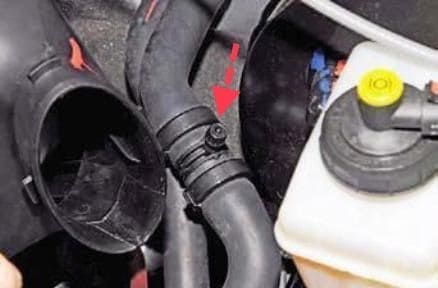
There is a fitting on the outlet hose of the heater radiator, and a screw plug on the thermostat housing to bleed air from the cooling system when it is filled with liquid.
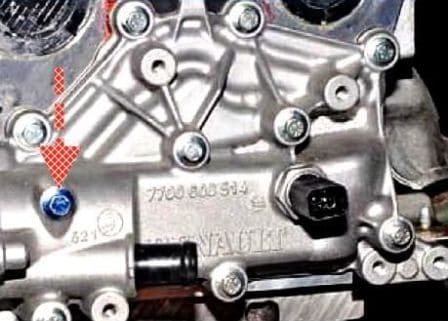
The fitting on the hose is closed with a cap.
On the 2.0 engine, with the help of two hoses connected to the nozzles of a plastic splitter (which also connects the inlet hose, the outlet hose of the radiator and the fluid supply hose to the pump pipe), fluid is circulated through the engine heat exchanger.

1 - hose supplying the pipes of the coolant pump; 2 - heat exchanger hoses; 3 - outlet hose of the heater radiator; 4 - inlet hose of the expansion tank; 5 radiator outlet hose; 6 - tee; 7 - splitter
The cooling system heatsink is attached to the fan shroud.
The radiator consists of two vertically arranged plastic tanks connected by aluminum tubes with cooling plates.

Cooling system radiator: 1 - left tank; 2 - attachment points of the right tank to the fan casing; 3 - right tank; 4 - radiator inlet pipe; 5 - radiator outlet pipe; 6 - attachment points of the left tank to the fan casing
The liquid enters the radiator through the upper pipe in the right tank, and is discharged through the lower pipe in the left tank.
There is no drain hole in the radiator.
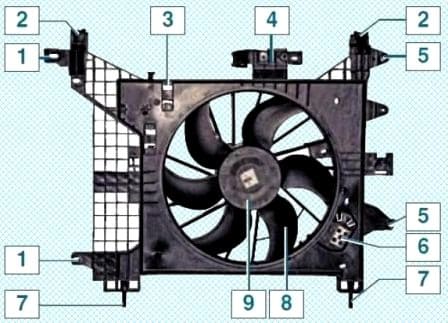
Radiator fan with casing assembly: 1 - holes for fastening the right radiator tank; 2 - bracket for the top fastening of the casing; 3 - casing; 4 - a collar of fastening of a reservoir of the hydraulic booster of a steering; 5 - holes for mounting the left radiator tank; 6 - additional resistor; 7 - finger of the lower support of the casing; 8 - impeller; 9 - motor shaft
The electric fan is installed in a casing, which is attached from above to the upper cross member of the radiator frame, and from below to the front suspension subframe.
With an increase in the temperature of the coolant, the fan turns on at the command of the electronic control unit (ECU) of the engine through a relay.
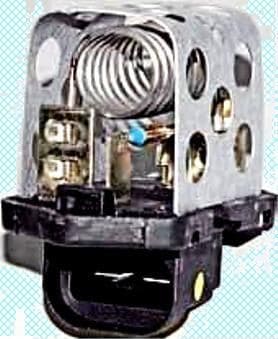
An additional resistor is installed on the fan shroud.
When the coolant temperature reaches 99 ° C, the computer turns on the fan motor through an additional resistor, and the fan rotates at low speed.
When the fluid temperature drops to 96°C, the fan will turn off.
When the coolant temperature reaches 102 ° C, the ECU turns on the electric motor, bypassing the resistor, and the fan rotates at high speed.
If the temperature of the coolant exceeds 118 °C, the engine overheat indicator lights up in the instrument cluster.
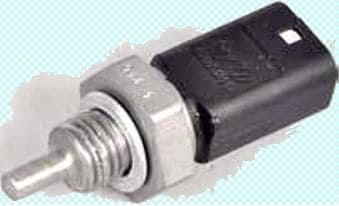
The coolant temperature sensor is screwed into the threaded hole in the thermostat housing.
The sensor provides information to the temperature gauge in the instrument cluster, the engine overheating indicator and the electronic unit of the engine control system.
Possible malfunctions of the cooling system, their causes and solutions
- Cause of malfunction
Remedy
Engine overheating:
- Reduced coolant level in the expansion tank
Add coolant
- The thermostat is faulty (the valve is stuck in the closed position)
Replace thermostat
- Faulty water pump
Replace water pump
- The radiator pipes, hoses and engine cooling sleeve are clogged with scale and sludge
Flush the cooling system and fill with fresh coolant
- Email The fan does not turn on due to an open circuit or failure of the sensor, relay or fan motor
Check and repair electrical circuits.
If necessary, replace the sensor, relay or fan assembly
- Damage to the valve in the plug of the expansion tank (the valve is constantly open, due to which the system is under atmospheric pressure)
Replace expansion tank cap
The engine overheats, cold air comes out of the heater:
- Excessive reduction in coolant level due to leakage or damage to the cylinder head gasket, which causes the formation of vapor locks in the engine water jacket
Repair the coolant leak. Replace damaged cylinder head gasket
The engine does not warm up to operating temperature for a long time, the thermal regime is unstable during movement:
- Faulty thermostat (valve stuck open)
Replace thermostat
Continuous drop in coolant level in expansion tank:
- The radiator is leaking
Change the heatsink
- Leaky expansion tank
Replace expansion tank
- Leaky water pump seal
Replace water pump
- Leaks of coolant through leaky connections of pipes and hoses
Replace hose clamps
- The cylinder head bolts are not tightened enough (during a long stop on a cold engine, coolant leaks at the junction of the block head with the cylinder block; in addition, traces of coolant may appear in the engine oil)
Tighten the cylinder head bolts to the correct torque
- The radiator is leaking
Replace heater core




